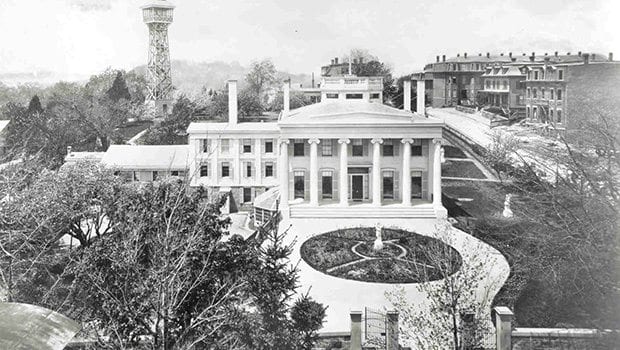

Historic Boston Initiative Executive Director Kathy Kottaridis says the renovation of the Kittredge House will help revitalize the surrounding Fort Hill neighborhood.
For more than 177 years, the Alva Kittredge house has been a commanding presence on Fort Hill.
The six Doric columns adorning the front of the high-style Greek revival house have seen scores of residents pass through the front door — prominent citizens of the Town of Roxbury, renters from the building’s decades as a landing spot for immigrants and clients of the Roxbury Action Program, which called the building home during the ‘70s and ‘80s.
In the 20 years the Kittredge House has been vacant the leaks and deferred maintenance took a toll on the building, as evidenced by a sagging portico and the decaying columns. When a real estate developer bought the building from the Roxbury Action Program with plans to cash in on the building’s prestige, preservationists grew worried.
The downturn in the economy and the city’s real estate market put the brakes on the developer’s plans and landed the Kittredge House in the hands of the Historic Boston Initiative. Now, after a one-year, $3.8 million rehab project, the house is almost completed with five two-bedroom rental units — two of them affordable — ready for the homes newest residents.
“We had to replace 30 to 40 percent of this structure,” says Historic Boston Initiative Executive Director Kathy Kottaridis. “It was in such rough shape.”
Alva Kittredge, a furniture manufacturer and real estate developer, built the house in 1836 when Roxbury’s Highland Park neighborhood was home to farms and large estates. The home originally fronted Highland Avenue and had a large addition extending to the south. Also on the estate was a large tower, erected on the site of remnants of the Lower Fort, a 1775 Revolutionary War fortification.
Kittredge was a founding member of the Eliot Congregational Church on nearby Walnut Avenue. In researching Kittredge in the church’s archives, Kottaridis found a framed photograph of the prominent Roxbury resident. Kittredge served as a Roxbury alderman prior the city’s annexation by Boston.
He was also a real estate developer, who purchased the land for the Forest Hills Cemetery.
He sold the Fort Hill estate to prominent Boston architect George Dunbar. In the late 1800s, the house was re-oriented to face Linden Street, where its facade has since been hemmed in by brick row houses. The additions to the house were demolished at that time.
The decline of the Kittredge House in the 20th century mirrored the broader pattern of capital flight and urban disinvestment in the United States. When the Roxbury Action Program bought the building in the 1970s, the neighborhood redevelopment organization helped reverse that tide.
“RAP did a lot of stabilization when they acquired it,” Kottaridis said. “But it’s really hard to maintain a historic building. At some point you have to do some serious capital upgrades.”
Capital upgrades are de rigueur for Historic Boston Incorporated, which has also renovated the 18th century Spooner Lambert House and the 19th century Cedar Street marble row houses in the Fort Hill neighborhood.
The nonprofit has its offices in the old Eustice Street Fire Station building, which it renovated two years ago, and is currently working on a plan to repair the Dale Street home where Malcolm X spent much of his teenage years.
Kottaridis said she expects the Kittredge House to be occupied by July. Currently, new interior walls, kitchens, heat and air conditioning systems have been installed. The reconstructed columns will soon be installed.
When the columns go up, the neighborhood’s beloved Greek revival edifices will be restored to its glory. And history will be preserved.
“Not only do we preserve the rich 19th-century history of this neighborhood, but it also re-activates a long empty building for new housing units that will support the continued growth and vibrancy of this community,” Kottaridis said.







